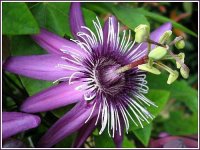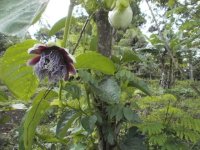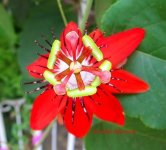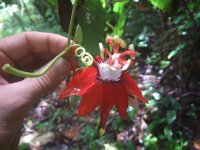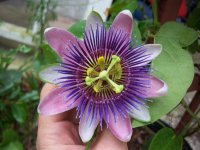..thanks, but wira, having not had a chance to read that P. incarnata paper..what was the exact methodology? while their abstract says "The efficiency of the method was demonstrated with Peganum harmala seeds.", i think most extractors would find p. harmala a lot easier/quicker to extract than passiflora's..something doesn't feel right here..
a lot of these more recent tests have simply soaked material in cold solvent for 15 mins to a hour..you can't efficiently extract alkaloids like this..most underground extractors report c0.2% alkaloid from P. incarnata..Eskil Hulin's proccedure i've outlined earler..this was a thorough extraction method (yielding 0.2%)
wira wrote:
if P. subpeltata contains principally Harman (as reported) than, from bioassay, either Harman is a very potent MAOI, or the Flavonoids in it are through-the-roof potent (compared to known flavonoids)..it was really not like harmine plants i've worked with..
.
so, i think we need more science/experiments, and need to stop searching for old info. on Passifloras..cause there isn't really a lot..
.
a lot of these more recent tests have simply soaked material in cold solvent for 15 mins to a hour..you can't efficiently extract alkaloids like this..most underground extractors report c0.2% alkaloid from P. incarnata..Eskil Hulin's proccedure i've outlined earler..this was a thorough extraction method (yielding 0.2%)
wira wrote:
..ok, ONE experiment..(& was the source verified) vs. most of the bio-medical community (including chemical suppliers) saying it's a potent MAOI..most of the work on Harman's MAOI activity and on the IC-50 values of Flavonoids has been done in the past 5-8 years..if there are no other reported human experiments like Ott's , i don't really think, given the enzyme evidence, that we can take it that seriously/definitively..i notice erowid comments of this experiemnt:The bioassay of harman + DMT was first reported by Ott in Ayahuasca Analogues as a self-experiment.
Sure, harman definitely shows MAOI activity in vitro in various non-human animal organs, but such activity has not been shown in vivo as far as I know. I'm not sure what more recent papers I have on harman; I'll have to dig out the older stuff from my files and find the IC data from those. I don't remember them finding it to be that potent as you report, but I haven't looked at this stuff for a while.
It should be mentioned that Gracie & Zarkov reported persistent and pronounced unpleasant side-effects when using Passiflora incarnata extract as an oral activator, which they did not experience from Banisteriopsis or Peganum. Whether this is due to the aforementioned β-carbolines in Passiflora or to other extracted components was never determined. As a general statement, Harman is usually by far the major alkaloid in the Passiflora species. Harmine and harmaline, when present, are most often present only in relatively small amounts.
if P. subpeltata contains principally Harman (as reported) than, from bioassay, either Harman is a very potent MAOI, or the Flavonoids in it are through-the-roof potent (compared to known flavonoids)..it was really not like harmine plants i've worked with..
.
so, i think we need more science/experiments, and need to stop searching for old info. on Passifloras..cause there isn't really a lot..
.

